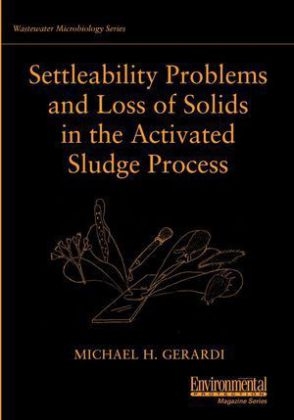
Settleability Problems and Loss of Solids in the Activated Sludge Process
Wiley-Interscience (Verlag)
9780471206941 (ISBN)
The activated sludge process is the most versatile, commonly used wastewater treatment system in North America; however, many activated sludge processes frequently experience operational problems related to poor compaction or settleability of secondary solids and loss of secondary solids from the clarifier. Eschewing the technical jargon and copious chemical equations found in the majority of wastewater studies, Settleability Problems and Loss of Solids in the Activated Sludge Process speaks directly to plant operators, showing them how to identify and solve common problems and achieve maximum efficiency. Michael H. Gerardi’s hands-on guide addresses the most common plant operational problems, such as increased costs, loss of treatment efficiency, and permit violations. Using numerous tables and illustrations, Settleability Problems provides microscopic and analytical techniques for troubleshooting and identifying the conditions responsible for settleability problems and loss of solids. It includes pictures of wet mounts and smears of acceptable and unacceptable microscopic conditions of the activated sludge and presents corrective measures for operational problems. Chapters include:
Undesired Filamentous Growth
Nutrient-Deficient Floc Particles
Denitrification
Slug Discharge of Soluble cBOD
Viscous Bulking or Zoogloeal Growth
Production and Accumulation of Foam and Scum
Volume II in the series, Settleability Problems will prove to be of unparalleled value to wastewater treatment plant operators as well as students of wastewater microbiology.
MICHAEL H. GERARDI, MS, James Madison University, and currently a research project associate at The Pennsylvania State University, is responsible for the development and presentation of wastewater biology courses. Previous to this appointment, he served as a technical coordinator and manager for the Williamsport (Pennsylvania) Sanitary Authority, where he was responsible for the operational and administrative functions of two activated sludge plants.
Preface.
PART I: OVERVIEW.
The Activated Sludge Process.
Floc Formation.
A Floc Formation Model.
Interruption of Floc Formation.
PART II: SETTLEABILITY PROBLEMS AND LOSS OF SOLIDS.
Introduction.
Undesired Filamentous Growth.
Nutrient-Deficient Floc Particles.
Denitrification.
Sheared Floc Particles.
Dispersed Floc Particles.
Heavy Metals and Congealed Floc Particles.
Low Dissolved Oxygen Concentration.
Young Sludge Age.
Floc Particles Lost Through Sludge Aging.
Slug Discharge of Soluble cBOD.
Viscous Bulking or Zoogloeal Growth.
Increase in Percent MLVSS.
Colloidal Floc Particles.
Temperature.
PART III: FOAM AND SCUM.
Production and Accumulation of Foam and Scum.
Identification of Foam.
Controlling Foam Production and Accumulation.
PART IV: SETTLEABILITY TESTING.
Settleability Testing and Settling Rate.
Settleability Testing: Microscopic Analyses.
Appendix I: F/M, HRT, MCRT, MLVSS, Sludge Age, SVI.
Appendix II: Microscopic Techniques.
References.
Abbreviations and Acronyms.
Chemical Compounds and Elements.
Glossary.
Index.
| Erscheint lt. Verlag | 18.10.2002 |
|---|---|
| Reihe/Serie | Wastewater Microbiology |
| Sprache | englisch |
| Maße | 179 x 257 mm |
| Gewicht | 340 g |
| Einbandart | Paperback |
| Themenwelt | Naturwissenschaften ► Biologie ► Mikrobiologie / Immunologie |
| Naturwissenschaften ► Chemie | |
| Technik ► Umwelttechnik / Biotechnologie | |
| ISBN-13 | 9780471206941 / 9780471206941 |
| Zustand | Neuware |
| Informationen gemäß Produktsicherheitsverordnung (GPSR) | |
| Haben Sie eine Frage zum Produkt? |
aus dem Bereich


